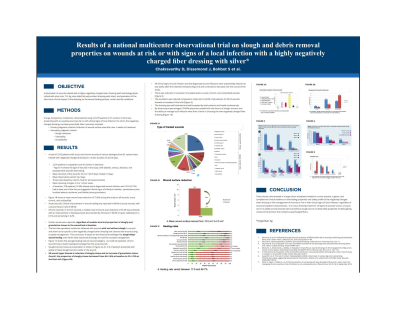Clinical Research
(CR-011) Results of a national multicenter observational trial on slough and debris removal properties on wounds at risk or with signs of a local infection with a charged poly-absorbent dressing with silver*

The aim of the study was to analyze slough reduction under treatment with a poly-absorbent dressing with silver* and the handling of the dressing in the management of wounds at risk or presenting signs of local infection, for an unselected patient population under real-life settings.
Methods:
An open, prospective, non-interventional, multicenter observational trial with a poly-absorbent dressing with silver* was conducted. Primary judgment criterion was evolution of wound surface area after 4 weeks treatment period. Secondary judgment criteria were slough reduction, tolerability, acceptability and handling of the dressing*.
Results:
Altogether 2,270 patients with acute and chronic wounds were included in 81 centers. Mean wound surface reduced from 10.5cm² to 2.9cm². At baseline, slough was recovering 48.1% of the wound bed surface area and decreased to 21.9% at the end of the follow-up. The exudation was reduced compared to initial visit in 63.8% of all patients, 57.6% of wounds showed no exudate in final visit. Most important impact factors for the choice of the dressing* were the slough-reducing properties (75.1%) and the dressing's effect against local signs of infection (72.6%).
Discussion:
These results demonstrate good slough-reducing properties and a positive effect against local signs of infection. In addition, the dressing* showed a good safety profile and should be considered as effective in the management of wounds presenting local signs of infection.

.jpeg)